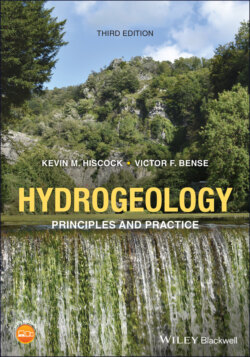Читать книгу Hydrogeology - Kevin M. Hiscock - Страница 45
Box 1.6 Groundwater resources potential in Africa
ОглавлениеCurrently, there are more than 300 million people in Africa without access to safe drinking water, many of whom are amongst the poorest and most vulnerable in the world (JMP 2010; Hunter et al. 2010). Even for those with access to improved water sources, there is growing evidence that domestic water use will need to increase substantially to help lift people out of poverty (Grey and Sadoff 2007; Hunter et al. 2010). In Africa, groundwater is the major source of drinking water and its use for irrigation is forecast to increase substantially to counter growing food insecurity. At present, only 5% of arable land is irrigated (Siebert et al. 2010), and there is discussion of the need to increase irrigation to help meet rising demands for food production in the context of future, less reliable rainfall (UNEP 2010, Pfister et al. 2011).
Increasing reliable water supplies throughout Africa will depend on the development of groundwater (Giordano 2009; MacDonald and Calow 2009). However, quantitative, spatially explicit information on groundwater in Africa is required to characterize this resource in order to inform strategies to adapt to growing water demand associated not only with population growth but also climate variability and change. To address this significant knowledge gap, MacDonald et al. (2011, 2012) have developed the first quantitative continent‐scale maps of groundwater storage and potential yields in Africa based on an extensive review of available maps, publications and data. From this analysis, MacDonald et al. (2012) estimated total groundwater storage in Africa to be 0.66 × 106 km3 (range 0.36–1.75 × 106 km3). Not all of this groundwater storage is available for abstraction, but the estimated volume is more than 100 times estimates of annual renewable freshwater resources in Africa.
Groundwater resources are unevenly distributed in Africa. The largest groundwater volumes are found in the large sedimentary aquifers in the North African countries of Libya, Algeria, Egypt and Sudan (see Box 1.3). Crystalline basement rocks have the lowest yields, generally less than 0.5 L s−1, though a significant minority of areas has yields that are in excess of 1 L s−1. Highest borehole yields (>20 L s−1) can be found in thick sedimentary aquifers, particularly in unconsolidated or poorly consolidated sediments. Depth to groundwater (Plate 1.7) is another important factor controlling accessibility and cost of developing groundwater resources. Water levels deeper than 50 m are not easily accessible by a hand pump. At depths >100 m, the cost of borehole drilling increases significantly due to the requirement for more advanced drilling equipment.
The aquifer productivity map (Plate 1.8) shows that for many African countries, appropriately sited and constructed boreholes will be able to sustain community hand pumps (yields of 0.1–0.3 L s−1) and, for most of the populated areas of Africa, groundwater levels are likely to be sufficiently shallow to be accessed using a hand pump. The majority of large groundwater stores in the sedimentary basins which can accommodate high yielding boreholes are in northern Africa. These are often far from population centres and have deep water levels and are therefore costly to develop. Away from the large sedimentary aquifers, the potential for borehole yields exceeding 5 L s−1 is not widespread, though higher yielding boreholes may be successful in some areas if accompanied by detailed hydrogeological investigation. The potential for intermediate boreholes yields of 0.5–5 L s−1, which could be suitable for small‐scale household and community irrigation, or multiple‐use water supply systems, is much higher, but will again require effective hydrogeological investigation and borehole siting. According to MacDonald et al. (2012), strategies for increasing the use of groundwater throughout Africa for irrigation and urban water supplies should not be based on the widespread expectation of high‐yielding boreholes but recognize that high borehole yields may occasionally be realized where a detailed knowledge of the local groundwater conditions has been developed.
Of particular focus, the population of sub‐Saharan Africa is currently about 1 billion, and is predicted to double by 2050, whereas the region’s climate is predicted to become drier during the same period (Healy 2019). Groundwater in sub‐Saharan Africa supports livelihoods and poverty alleviation and maintains vital ecosystems, owing to its widespread availability, generally high quality and intrinsic ability to buffer the impacts of episodic drought and pronounced climate variability that characterize this region (Cuthbert et al. 2019). Therefore, it is impotent to understand the renewability of groundwater under present and future climatic conditions. The sustainability of groundwater in sub‐Saharan Africa in response to future climate variability depends critically on the relationship between precipitation and recharge. Cuthbert et al. (2019) presented an analysis of multi‐decadal groundwater hydrographs across sub‐Saharan Africa and showed that levels of aridity determine the recharge processes, whereas the local groundwater conditions influence the type and sensitivity of precipitation‐recharge relationships. Cuthbert et al. (2019) found that intense precipitation events, even during years of lower overall precipitation, can produce years with the largest recharge in some dry subtropical locations, and so challenging the general consensus of decreasing water resources in such regions under climate change.
